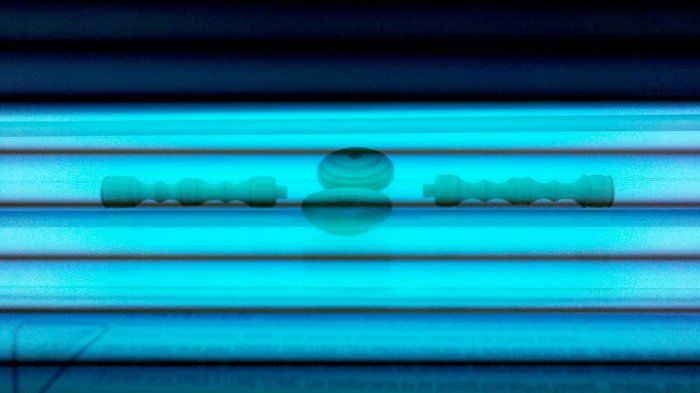
John Greco's cherry candlesticks catch some rays in a tanning bed. He let them sit there for 12 minutes.
In a recent phone conversation, John Greco mentioned to me that he had been trying get some padauk to achieve that nice, deep red color that he prefers to the garish red of the freshly-milled wood. His method of choice had been to go solar: foil-coated pieces of cardboard, cleverly arranged on his backyard picnic table. A great method, methinks, and easy on the kilowatts.
But recent cloudy weather put a damper on getting a similar look for some cherry candlesticks he had just made for his daughter’s “Monte Carlo Night” fundraiser. John mentioned that his spouse remarked: “Too bad you can’t just throw it on a tanning bed.”
Well, actually…you can. And John did. (Many thanks to his wife for the suggestion.)
The best part of this story, John mentions, was having the tanning salon attendants ask: “Um, are you going to be going into the tanning bed WITH the wood?”

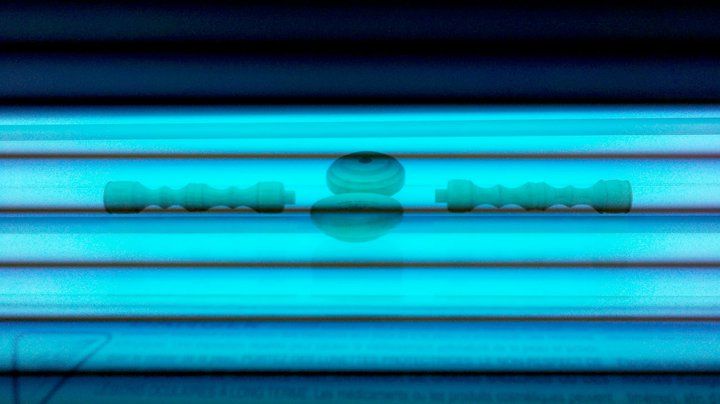
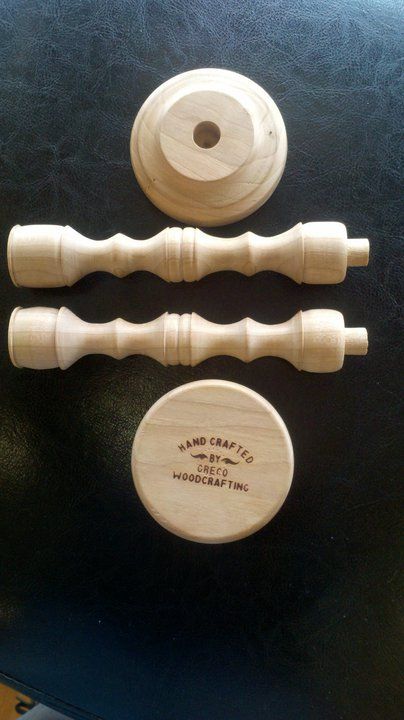
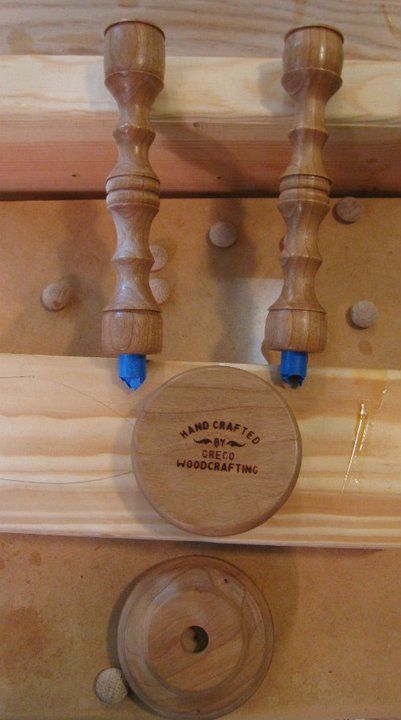
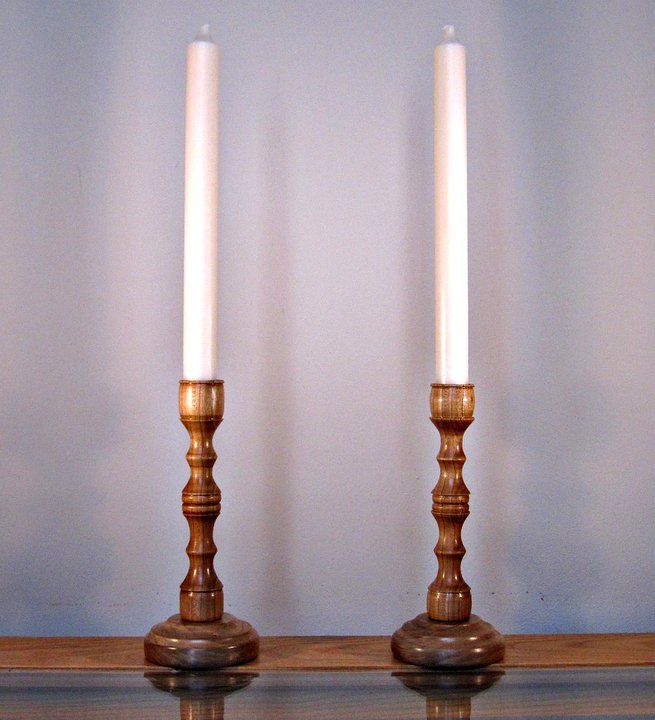






















Comments
Thanks for posting this, Vlad- I truly do appreciate it :)
One tip I want to point out for anybody trying this was that I had the pieces really spread out using most of the bed space to ensure they were getting full UV coverage. For purposes of taking the picture, I arranged them closer together.
Of course if you give it a try, don't forget your tanning goggles. It gets bright in there!
I've also noticed that unfinished pieces of cherry tend to age a lot faster than finished ones. Some of that could be the UV protection a lot of finishes impart, but I also wonder if oxygen helps speed the process along. Cool trick, though, I love the look of naturally aged cherry!
I've also noticed that unfinished pieces of cherry tend to age a lot faster than finished ones. Some of that could be the UV protection a lot of finishes impart, but I also wonder if oxygen helps speed the process along. Cool trick, though, I love the look of naturally aged cherry!
How much time does it take to get some color to the wood?
Would this also work for other types of wood? How long did you leave the wood in the tanning bed? Any other tips for doing this? I know you can age cedar to get that grey color by mixing water and baking soda and spraying on the wood as well
@coack - I left the wood in the bed for 12 minutes, the maximum length of time this particular salon allows the beds to be used for. From then to the final picture it was ~2 days of letting that reaction take place.
@Drew7 - The more tannins the wood has, the bigger reaction it will have to UV. I use the sun regularly to change Padauk from orange to deep red. I tried the same for the Cherry, but clouds were hampering my efforts.
Thanks for reading :)
Application of a strong alkaline liquid such as oven cleaner will darken cherry quickly. The trick is getting it applied evenly, as the chemical reaction takes place rather quickly.
Makes me wonder what you could do with an inexpensive black light tube in the comfort of your own shop.
In his book "Finishing", Jeff Jewitt suggests to suntan wood by first applying linseed oil or tung oil and placing it in the sun for a day or more. I tried it with a piece of scrap by first applying some clear varnish I had and the color was beautiful after 3 or 4 days outside.
I've just finished a cherry grandfather clock that I'm planning to finish using this method. However, I'm hesitating because I don't know if the lighter color sapwood will darken as much as the darker wood. It might be better to stain the piece first to even out the colors. Has anyone tried suntanning cherry with different colored boards?
I have a small garage shop. Sometimes I like to work with the big door open and roll my DJ20 and planer outside. I have noticed that if I take a break for a little while (lunch or kids interupting) in the middle of stock prep there is a noticable darkening of cherry in that short amount of time.
Bottom line: sit cherry out in the sun for an hour (or several) and it will get significantly darker. But only do it after all the surface prep and sanding is done or it will be removed during those steps.
Were the pieces turned periodically to even out the exposure or left in the same position for the 12 minute exposure?
5% solution... Potassium Di-chromate darkens cherry to a deep rich tone. The drawback is the grain raising that takes place by wiping it down with the solution. Nothing oooo steel wool can't handle. Raising the grain is one of your steps anyway, if your finish is water soluble. The chemical requires some safety during use, but no more than any other poison you already own in your shop. I first moisten the wood with straight water, then wipe on a 5% solution and let dry overnight. My finish of choice happens to be varieties of shellac. No method I've tried produces the evenness and richness of tone.
Finally, a good use for tanning beds. The primary purpose for the things is foolhardy, as anyone who has had skin cancer knows. If they changed their business model to "woodwork tanning salons" they might improve their profits and provide a healthier product to the public to boot. Hmmmm, business opportunity anyone?
I recently made kitchen cabinets of maple and simply wipe-varnished them clear. When I got to the other side of the room two months later, the color of the original work was modestly darker. So, I took the drawer faces outdoors for a sun treatment of five or six hours and matched the original work.
I have had great success on cherry by wiping on a coat of lye solution. The wood instnatly ages 100 years. After 15 years in my living room, I see no detrimental effects.
This is a very old alternative that I have used for many years. Keep in mind that the Lye you buy in cans is not the same as I use. If you use it, your finishes will react and not work.
Put some oak ashes into a funnel with a coffee filter or fine cloth filter in the bottom. Pour water through. It will leach out a base that used to be called lye. Check by rubbing some of the liquid between your fingers; bases feel slippery.
Liberally coat the cherry and let dry. Repeat. Then smooth with XXXX steel wool. In a few days the cherry will acquire the same color as wood exposed to sunlight.
It's great that there are so many variants and apparent options for aging cherry. Sounds like they are of two variants by the looks of this thread: the tanning oil (tung) version, and then the photo-developer version (using some sort of alkali such as lye, potassium bichromate, etc). My youngest brother, a filmmaker and photographer, is currently experimenting with alternative developing techniques and has use everything from new dilutions of traditional developers, to coffee, even hair dye! Maybe aging wood--like developing film--will be a better, more artistic, purpose for some of the toxic stuff we encounter in our daily lives.
Keep experimenting! And let us know how it goes.
I read an article where they put on boiled linseed oil cut with 50% mineral spirits before putting the cherry in the sun. I'm in the process of trying that on some scrap wood, but it's been cloudy and thwarted my efforts. I do have one of those super bright lights they use lift your spirits in the winter. After reading your post, I'm going to try that instead and experiment with bare wood and the BLO mixture. I'll put some masking tape on the test pieces to see which works better.
FYI, cherry has lots of tannins, which is why it reacts to sunlight more than most other woods which have fewer tannins. I don't know much about exotic woods, though.
Log in or create an account to post a comment.
Sign up Log in